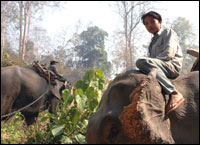At a fork in the road, our guide points to the right. “That’s the main road there,” he says. “We’ll go on this smaller road, deep into the jungle.” A glance to the left reveals a narrow, unpaved track, which he tells us is used primarily by logging trucks. It’s the dry season in Myanmar, and dead leaves hang like bats above us. The truck’s idling motor blends with the cacophony of insects.
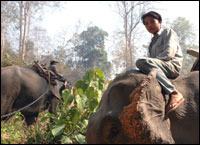
Beasts of burden.
Photos: Jennifer Hile.
I’m sitting next to one of Asia’s most dedicated elephant conservationists, Sangduan “Lek” Chailert. In 1995, Lek sold her home and car, using the proceeds to start the Elephant Nature Park sanctuary in her native Thailand. She also runs a program called Jumbo Express, bringing free medical care to the animals and their owners in the countryside.
Lek’s nickname means “little.” She barely tops five feet, and looks to weigh around 100 pounds — yet she’s spent her adult life throwing a shoulder against the monumental downhill slide of Asian elephants. Three years earlier, I had made a documentary about the sanctuary for National Geographic. A few months of following her around with a camera had left me in awe of her work; when she invited me to meet her for this trek, I jumped at the chance.
Lek — whose shaman grandfather was once awarded an elephant for saving a man’s life — has heard that the animal’s numbers in Myanmar (formerly known as Burma) are relatively stable. That’s a stark contrast to the rest of Asia, where populations have been shattered by poaching and deforestation. “This country,” she tells me, “is one of the last places of hope.”
Pachyderms of Endearment
Myanmar is one of the last places in the world to see the centuries-old Asian tradition of domesticated elephants and their keepers working side by side. There are said to be hundreds of animals laboring throughout the country, but the very thing protecting elephants there may one day do them in. Many of them are used for logging; the country is home to more than half of Southeast Asia’s remaining closed-canopy forest. As we plan our visit to logging camps in the central hinterlands, we know we will see a practice riddled with irony: these creatures are surviving because they’re shielded from harm — solely for the purpose of destroying their own habitat.
Just how many elephants we’re talking about is unknown. As I prepared for my trip, I expected population numbers to be tough to find — Myanmar’s iron-fisted military government keeps it largely sealed off from outside observers — but I was stunned to learn that current stats are all but nonexistent for all of Asia. A lack of funds, and often political will, means on-the-ground counts have been few and far between. (International wildlife conservation organizations have also faced criticism for working with ruthless leaders such as those in Myanmar for any purpose.)
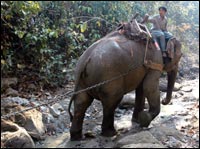
Haul in a day’s work.
Simon Hedges, Asian elephant coordinator for the Wildlife Conservation Society, confirmed my finding. He emailed me an article he coauthored for Conservation Biology in 2004. “For many forest elephant populations, existing knowledge is often so inadequate that even deciding which are the most important populations to protect is not possible,” the authors wrote. “The frequently cited global estimate of 30,000 to 50,000 Asian elephants is often acknowledged as little more than an educated guess … Astonishingly, these estimates of the global population have been accepted without revision for a quarter of a century, despite major losses of Asian elephant habitat over this period.”
When we spoke, Hedges was preparing to launch a study of the number and distribution of elephants in Myanmar’s Hukaung Valley. Its vast forests provide ideal habitat, and scientists hope to find robust populations there. “What we already know about [the country], however, suggests there are smaller numbers of elephants than people had hoped,” he told me.
Wildlife biologist Peter Leimgruber, of the conservation unit of the Smithsonian’s National Zoological Park, has spent years studying the country and its wild herds. Results from a recent search are called “sobering” on the Smithsonian’s website. Leimgruber’s team sighted wild elephants only twice, and the amount of dung they encountered “implies populations are significantly smaller than expected,” he told me.
“I definitely would still consider the country a stronghold for the species,” Leimgruber says, citing the amount of remaining forest and the importance of elephants to the culture. “But it’s amazing how much we don’t know.”
What we do know is this: Asian elephants once grazed by the Yangtze River in China and in the dark forests of Sumatra. Their range covered nearly 3.5 million square miles. Now it’s estimated at about 188,000 square miles total — a 95 percent reduction — spread across 13 countries. It’s a patchwork of shrinking forests, fast being dismantled and piled into the logging trucks that rumble along the continent’s back roads.
Tusk, Tusk
My trip with Lek started four days ago at a guest house next to the glittering, colossal temple of Shwedagon in Yangon (Rangoon). We rented a car and headed for the small town of Taungoo, in central Myanmar. I was beginning to wonder if we’d manage to find any elephants, given the grim statistics. But it didn’t take long. Just outside Yangon, we saw our first — in chains.
Myanmar’s Department of Forestry keeps albino elephants on display for the general public. With pink skin covered in short white hair, these curiosities looked as if they’d been sprinkled with powdered sugar. They stared back at me with eyes the color of pearls. I watched as the youngest paced back and forth, reaching toward the others, bellowing and trumpeting with frustration. He will most likely spend the rest of his life tethered to this platform. White elephants, considered sacred throughout Asia, are said to bring peace and prosperity to a nation. Leave it to a military junta to shackle their good omens.
Lek and I didn’t linger. As we drove off, she mused on the complexities of the situation. “In Asia, elephants are a very mystical creature, a holy animal,” she said, important to both Hinduism and Buddhism. “But the elephant is also used for work and making money.” That contradiction means the animals are both revered and violently subdued throughout Asia.
When we reached Taungoo, we asked the manager of our guest house to find Maung Soe, a guide whom Lek had met three months earlier, and — poof — within a half hour he appeared. “Easy to find elephant logging camps,” he assured us. “Be ready at 5:30 tomorrow morning.”
Now, on our fourth day out, we’ve been driving for five hours when Maung Soe points out the fork in the road. Before continuing on, Lek and I hop out to stretch our legs. She spies elephant dung, then soldiers — evidence of what we came here hoping to find, and what we most hoped to avoid.
As the soldiers approach, wearing olive-green uniforms with old rifles slung over their shoulders, I realize they are younger than I’d expect. It’s quickly obvious that they aren’t concerned with us. No one asks for passports, a bribe, or any of the other harassments you hear foreigners subjected to in this hermetic kingdom. Instead, they tell us they’re here to monitor logging operations, pointing to the small hut where they stay. It reminds me of a stranded whale carcass: ribs of bamboo arch across the top, with a few pieces of ripped, gray canvas overhead. A fetid trickle of river runs adjacent.
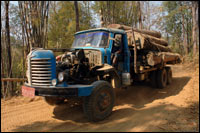
Trucks pick up where trunks leave off.
It’s no surprise the government keeps an eye on logging. In 2004, the timber trade brought in $430 million — 15 percent of the country’s export earnings, according to the U.K.-based Global Witness. Of that, $300 million came from teak; Myanmar provides 75 percent of the international supply of that popular wood.
In fact, increasing global demand for teak and other woods means the illegal trade is flourishing. “The most severe logging is taking place in northern Myanmar” along the border with China, explains John Buckrell, a campaigner for Global Witness. In recent years, he says, “over 98 percent of the timber imported annually into China across the border was illegal.” Buckrell adds that the area has been described as “one of the world’s hottest biodiversity hotspots.”
But logging with elephants may actually be keeping the devastation in check. “The cutting is done selectively, one tree at a time, as opposed to clear-cutting,” explains Matthew Lewis of the World Wildlife Fund’s Asian Mammal Conservation program. “That does a lot less damage to the forest” and doesn’t require new roads to be built.
And though the work is hard on the animals — especially on their skin and spines, Lek tells me — it may be better than the alternative. When domesticated elephants are replaced by logging machinery, Lewis says, their numbers usually plummet. They are often abandoned and become crop raiders, likely to be shot by farmers. Or — like many of the 3,000 elephants that were put out of work when Thailand outlawed logging in 1989 — they wander dusty city streets as a tourist attraction. There is little wild to return to.
Let’s Get Trunky
Lek and I shake hands with the soldiers, then jump back in the truck, bumping along for another three hours. The engine dies periodically. When the driver gets out, he sinks into ankle-deep dirt as soft and thick as fresh snow. We haven’t seen an elephant today, but we’ve passed 16 logging trucks so far, their open beds piled sky-high.
We drive southwest all day and the next before reaching the village of Pyaung Chaung Wa, a cluster of bamboo huts along a shallow river. It’s dusk, and the men are coming home from a day’s work; Lek and I are both thrilled to see a line of elephants stretched behind them. Four adult animals lumber along, while one baby stays within trunk’s reach. She periscopes her trunk in our direction when she sees us, sniffing the air, then darts behind her mother’s formidable backside.
The villagers gather the animals by the river and slide off their harnesses. The elephants, wearing bells around their necks, wander slowly down the bank to graze. The late-afternoon light casts the scene in a dark, filtered gold.
Maung Soe points Lek and me toward a small, open platform where we’ll sleep. It stands on stilts near the river; chickens nest beneath the floor. Children gather around us, and Lek starts giving out whistles and balloons donated by a volunteer at her sanctuary. In no time, every child is blowing like crazy.
“I worry that maybe one day there will be no elephants left,” says Lek that evening, after a dinner of soup with fried noodles and basil cooked over an open fire. “I think without them, maybe all of Asia [will be] like an empty culture.” As we talk, a crowd of people three deep encircles our sleeping platform. Every time I open my backpack or camera case, heads crane to see inside. Travelers are rare in this area, and TV and radio nonexistent. Tonight, Lek and I are the villagers’ entertainment.
At dawn on my second morning at camp, the surrounding canyons blurred by mist, I see the elephants marching slowly toward the village with a hodgepodge of men and boys. I join the mahouts, or elephant keepers, to bathe the elephants in the river, tossing bucketfuls of frigid water over massive gray backs. The villagers are clearly surprised at my interest in their daily life, but are welcoming and helpful. (Women in this society are strictly caregivers and cooks, but as a foreigner, I’m exempted from social norms.)
After the bath, the mahouts tie a wooden harness to each animal and we head into the jungle, a trail of chains dragging behind us. We hike to a hillside where the villagers had cut down a dozen trees a few days earlier. Now the mahouts de-limb the trees with an axe. Then they quickly wrap the chain attached to the first elephant’s harness around the base of one of the trees. Bamboo whips hover threateningly as she starts moving. “Chiti! Shet tho!” the mahout hollers. Maung Soe translates the directions behind me: “Left! Forward!” The elephant maneuvers carefully down the steep hillside, the tree dragging behind at odd angles, catching on debris.
At the bottom of the hill the elephant crashes into the river, deep enough in places for the 500-pound log to half-float behind her. The rest of the elephants and their cargo soon follow. The caravan begins making fast progress, kicking up spray. The canyon walls tower above us, and bird calls echo all around. I feel as if I’ve stepped into an ancient painting.
Sixteen Tons, and Whaddaya Get?
Later that morning, near the village, one of the elephant keepers points out a monster tree protruding horizontally from the base of a cliff. He guesses it weighs well over a ton. It fell years ago, and looks cemented into the granite rocks. Nonetheless, soldiers have ordered the villagers to extricate it so it can be used to build a nearby bridge. With trepidation, the men chain two elephants to the ancient tree.
The animals trumpet with the effort of trying to heave it forward. The men start shouting commands, hitting the elephants with bamboo whips, urging them on. The tree doesn’t budge. The elephants are straining so hard, their foreheads come within a few feet of the ground with every tug.
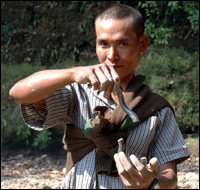
Never break the chain.
With a loud crack, part of a chain snaps, and one of the elephants hits the ground hard, face first. A lesion on her stomach, probably from the friction of the chain, bursts open. The pressure of the work is obvious as the elephant struggles back to her feet. Today, this team catches a break. It is considered bad luck for an elephant to be seriously injured, so the men don’t tempt fate. They quietly take off the chains and let the elephants off to graze — the soldiers will have to wait.
Back at camp, I’m eating more noodle soup when I look up to see an elephant dragging our overheated truck up a hill in the distance. Maung Soe had been fiddling with the engine, trying to figure out why it kept quitting, and it died again. The villagers decided to help out by using the local power source. Now Maung Soe sits behind the wheel as the truck moves forward, driver’s-side door thrown open, trying to rev the engine back to life.
While I stare at the scene, a few people around me stare at a Vanity Fair magazine I’ve pulled out of my pack. I find myself wondering if we’ve already done too much damage to the truck’s engine to salvage it. And then I can’t help but think of the piecemeal destruction I’ve already seen, and of the work of Lek, Leimgruber, and Hedges. Theirs is an uphill battle indeed.
